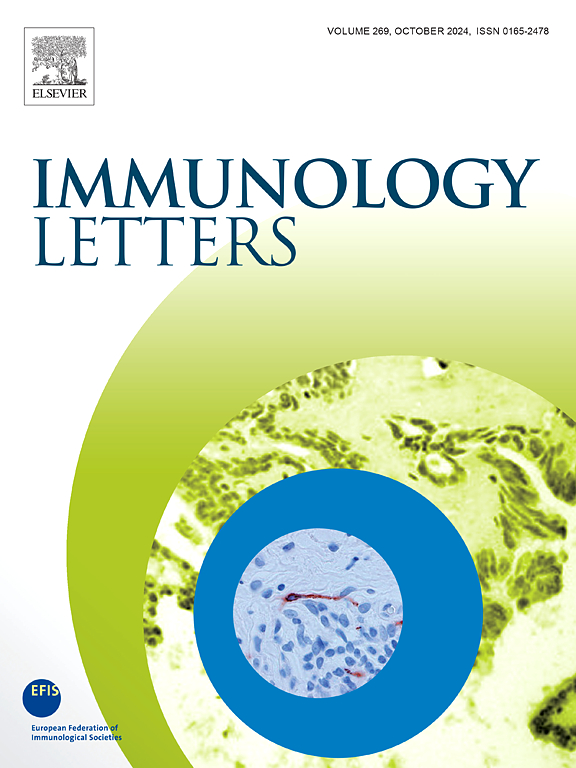Gut microbiota analysis revealed unique biomarkers in Ankylosing Spondylitis and Non-radiographic Axial Spondyloarthritis
IF 2.8
4区 医学
Q3 IMMUNOLOGY
引用次数: 0
Abstract
Objectives
In this paper, the different characteristics of gut microbiota between Ankylosing Spondylitis (AS), Healthy Control (HC), and Non-radiographic Axial Spondyloarthritis (nr-axSpA) were studied. The AS-nr-axSpA differentiation model was constructed to identify patients with these two phenotypes and help doctors make accurate diagnosis.
Methods
Stool samples and blood samples of AS, nr-axSpA, and HC were collected from our hospital. Bacterial lipopolysaccharides and lipopolysaccharides-binding proteins in blood were detected by enzyme-linked immunosorbent assay (ELISA). The V3-V4 region of bacterial 16SrRNA was analyzed by MiSeq PE300 sequencing platform with high throughput. Software such as QIIME, R, Excel, etc. were used for statistical analysis of the data. Random Forest (RF) and Area Under Curve (AUC) methods were used to construct the AS-nr-axSpA differentiation model and identify relevant important markers. Set markers and use the receiver operating characteristic curve (ROC) to judge the accuracy of the model.
Results
We studied a total of 59 fecal and corresponding blood samples from 31 AS, 21 nr-axSpA, and 7 HC. There was a significant difference in intestinal α diversity between AS and nr-axSpA patients (Shannon index, P = 0.017). Compared to the nr-axSpA patient population, Streptococcus (P = 0.045), Actinomyces (P = 0.0028), Rothia (P = 0.042), and Oribacterium in the intestinal tract of AS patients P = 0.044) increased significantly. However, Dorea (P = 0.034) and Odoribacter (P = 0.043) were significantly reduced. The AS-nr-axSpA model was constructed using 18 factors including Actinomyces and Odoribacter. ROC analysis was performed on the model and an ROC curve was drawn, with an AUC of 0.78, which is moderate accurate.
Conclusions
The gut microbiota of patients with AS differs from that of patients with nr-axSpA. The disturbance of gut microbiota may be one of the conditions for the progression of nr-axSpA to AS. The characteristics of gut microbiota and related bacterial products may serve as characteristic factors for differentiating the phenotypes of these two diseases. The AS-nr-axSpA model may help doctors distinguish patients with different phenotypes, but more robust prospective and standardized studies are needed to confirm these findings.
肠道微生物群分析揭示了强直性脊柱炎和非放射性轴性脊柱炎的独特生物标志物。
目的:研究强直性脊柱炎(AS)、健康对照组(HC)和非影像学中轴性脊柱炎(nr-axSpA)患者肠道菌群的不同特征。构建AS-nr-axSpA分化模型,识别这两种表型的患者,帮助医生准确诊断。方法:采集我院AS、nr-axSpA、HC的粪便标本和血液标本。采用酶联免疫吸附试验(ELISA)检测血液中细菌脂多糖和脂多糖结合蛋白的含量。采用MiSeq PE300高通量测序平台对细菌16SrRNA的V3-V4区进行分析。采用QIIME、R、Excel等软件对数据进行统计分析。采用随机森林(Random Forest, RF)和曲线下面积(Area Under Curve, AUC)方法构建AS-nr-axSpA分化模型,识别相关重要标记。设置标记并使用受试者工作特征曲线(ROC)来判断模型的准确性。结果:我们共研究了31例AS、21例nr-axSpA和7例HC的59份粪便和相应的血液样本。AS与nr-axSpA患者肠道α多样性差异有统计学意义(Shannon指数,P=0.017)。与nr-axSpA患者相比,AS患者肠道链球菌(P=0.045)、放线菌(P=0.0028)、罗氏菌(P=0.042)和Oribacterium的数量显著增加(P= 0.044)。Dorea (P=0.034)和Odoribacter (P=0.043)明显减少。采用放线菌、恶臭菌等18个因子构建AS-nr-axSpA模型。对模型进行ROC分析,绘制ROC曲线,AUC为0.78,准确度中等。结论:AS患者的肠道菌群与nr-axSpA患者不同。肠道菌群紊乱可能是nr-axSpA向AS发展的条件之一。肠道菌群和相关细菌产物的特征可能是区分这两种疾病表型的特征因素。AS-nr-axSpA模型可以帮助医生区分不同表型的患者,但需要更强大的前瞻性和标准化的研究来证实这些发现。
本文章由计算机程序翻译,如有差异,请以英文原文为准。
求助全文
约1分钟内获得全文
求助全文
来源期刊

Immunology letters
医学-免疫学
CiteScore
7.60
自引率
0.00%
发文量
86
审稿时长
44 days
期刊介绍:
Immunology Letters provides a vehicle for the speedy publication of experimental papers, (mini)Reviews and Letters to the Editor addressing all aspects of molecular and cellular immunology. The essential criteria for publication will be clarity, experimental soundness and novelty. Results contradictory to current accepted thinking or ideas divergent from actual dogmas will be considered for publication provided that they are based on solid experimental findings.
Preference will be given to papers of immediate importance to other investigators, either by their experimental data, new ideas or new methodology. Scientific correspondence to the Editor-in-Chief related to the published papers may also be accepted provided that they are short and scientifically relevant to the papers mentioned, in order to provide a continuing forum for discussion.
 求助内容:
求助内容: 应助结果提醒方式:
应助结果提醒方式:


